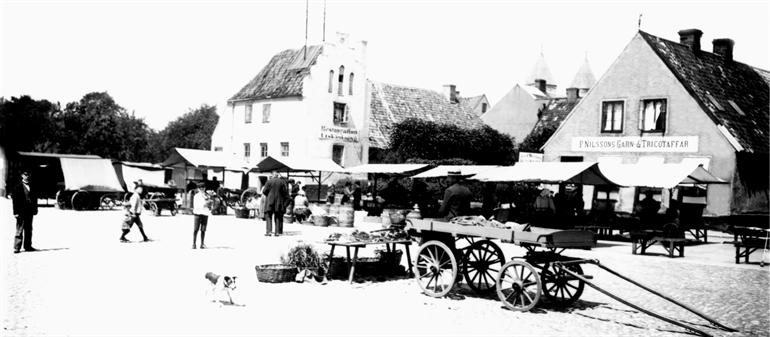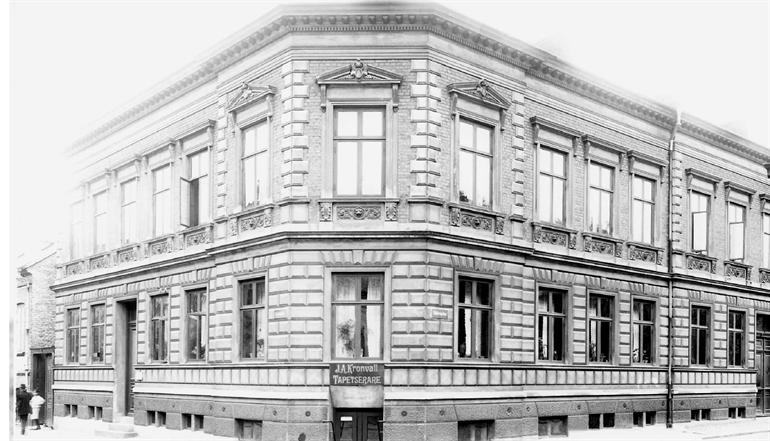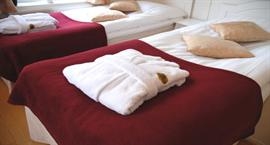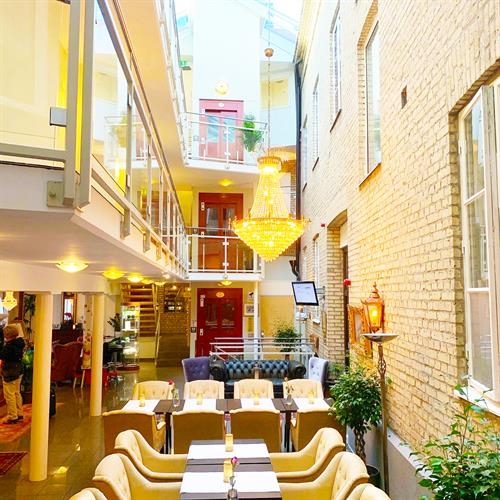The history of Lund

Mårtenstorget, 1905
The city of Lund is more than 1000 year old and so much exciting things have happened in this city. You can read about some of the "cornerstones" below.
Time flies
In 1970, the city of Lund celebrated 950th anniversary, but already 20 years later it was time for the 1000th year anniversary. The reason for this was that after having made excavations near Kattesund, it was made possible to specify the founding of Lund to the year of 990, when Sven Tveskägg ruled. His son, Knut The Great, founded a mint in winter of 1019-1020. In that way the importance of the city could be secured.
Archbishopric in year 1103/1104
The most important event in the early history of Lund was that the city was elevated to become the archbishopric of the Nordic countries in 1103/1104. There is a far distance between Sweden and Italy. The pope of Rom, Paschalis II elevated Lund to a Nordic archbishopric after pressure from king Erik Ejegod in 1103. But the first archbishop Asker did not receive the message from the holy pope until in 1104. Even in 1060 an english kaplan from the court founded by Knut den Store, had become the first archbishop of the Archbishopric of Lund, but Lund had been controlled by the of Archbishopric Hamburg-Bremen.
27 churches and monastries
During the Middle Ages, Lund was a church centre. The town was the spiritual capital of Denmark and was referred to as both Metropolis Daniae and the Nordic Rome. Thanks to a donation from the holy Knut in year1085, the possibility was made to build a cathedral. The gift also led to the founding of a cathedral school. "Katedralskolan"
At the same location as a smaller church used to lie, the Cathedral of Lund was built to honor S.t Laurentius. The western section of the church and the crypt was finished in 1123. In 1145, Eskil consecrated the main cathedral building. At the most, Lund had 27 churches(!) in or just outside the city centre. At the time of the big Reformation, all were destroyed except for the cathedral and .Today, Drotten´s church has been dug out and is now a museum.
Remains of the lost days of glory
Today only a few of the medieval buildings are left intact. Kalendehuset, Krognoshuset, Liberiet, Lundagårdshuset and Stäket can give us an image of what Lund might have been like during this medieval period. In year 1134, the city was expanded with surrounding walls and banks. Stadsparksvallen - Högevall - is today the only remaining part, but one can easily find signs from this period of time when looking on a map of lund: Södra Esplanaden, Östra Vallgatan, Biskopsgatan, Allhelgona Kyrkogata, S:t Laurentiigatan, Clemenstorget, Bangatan. In each one of the four cardinal points there was an entrance - customs check. The names of these areas are still in use: Södertull, Östertull, Norrtull and Västertull. The walls and banks was a way to protect the city from outer threats.
The city on fire
When it came to catastrophes occurring within the city wall, there was no protection. Violent fires rages over and over again in the following years: 1172, 1234, 1263 and 1287. Even in the 14th century, Skåne had for at short period of time been controlled by the Swedish king. But not much time passed before Skåne was back in the hands of the Danish kingdom. In 1360 king Valdemar Atterdag once again conquered Skåne. He celebrated his victory by spending Christmas in Lund.
The Swedes
The Swedes made new attempts to conquer Skåne. Lund was fiercely attacked in year 1452 by the army of Karl Knutsson and a large part of the city was set on fire. The cathedral was rebuilt and just in the beginning of the 16th century the work of embellishing the Cathedral started. In 1505-1527 Adam van Duren rebuilt the Cathedral and also added another level to the towers. He was a great artist, who also embellished the church with art portraying human beings and animals. In 1525 there was another battle of Lund. In Denmark there was a war going on that was named Grevefejden ( "the feud of the counts"). The Scanian farmers supported Christian II, whom they wanted to come back into power.
The church looses its power and Lund becomes a "small town"
Because of the Reformation, Lund's era as the centre of power is over. As the church lost the power struggle with the government, Lund also lost its unique position. In 1536, Christian III had archbishop Torben Bille imprisoned, and this crushed the power of the church completely. All the Danish bishops were dismissed and replaced by evangelical superintendents. In 1537 Frans Vormorden became superintendent. In 1550 Christian III ordered to demolish all the churches in Lund. The Cathedral and Klosterkyrkan were the only ones left untouched.
Royal gift became the foundation of the hospital
In 1578-84, Fredrik II had a house built close to the Cathedral. The house remains still today at the same location in Lundagård; it's called Kungshuset or Lundagårdshuset. The same king, Fredrik II, donated in 1567 some land, located in the south of Lund, to the cantor of the Cathedral. The profits were donated to the poor. In 1756 the decision was made to let the profits go to the building of a hospital. At the start, the hospital was very small and could offer not more than two beds for patients. The first pharmacy in Lund, later to be called "Svanen" was founded by Esaias Sleishcher in 1627. The pharmacy is still located at the same spot, but in a newly build house.
War, war, war and university
In 1644 the Swedish army had its headquarters in Lund, and was therefore laid waste by the Danes. However, the Danes were not successful and during the peace agreement in Roskilde in 1658 they lost Skåne to the Swedes. As a step in the process of making Skåne and the other landscapes Swedish, the decision was made to found a university in Lund. Bishop Peder Winstrup had the first academic printer of Lund, Vitus Haberegger, to print the preacher he had held in the Cathedral of Lund at the opening of the university. The new university also appointed an academic bookseller - Adam Junghans. Despite the peace that had been made in 1658, the hostilities were far from over.
The Swedish King
The Swedish king Karl XI had to struggle to protect his newly conquered province. In a snowstorm and with great losses from both sides, the Battle of Lund was fought in 1676. The Swedish army was led by field marshal Simon Carl von Arensdorf. After the battle, bishop Peder Winstrup invited the victor for dinner. He would have preferred to have Christian V as guest of honour. The war was lasted a long time and the city was set on fire by the Danes in 1678. Out of the 304 houses in Lund, 163 were burned to the ground. The year after, peace was finally made. On the night of the 26th of September 1670 the peace treaty was signed, probably in Kalendehuset, a house that still remains today. Lund´s position in the new kingdom was not lower than it had been in Denmark. The Cathedral kept its property and in 1681 the decision was made for Lund to continue as a Archbishopric in the future.
The country is ruled from Lund
Lund had lost power, importance and welfare trough the war and the Reformation, and was in the beginning of the 18th century struck by further difficulties. Swedish and Danish troops alternated to be placed in the city. Fires raged in the years 1703 and 1711, and the bubonic plague claimed numerous victims in 1712-1713. This city, which had gone through a number of trials, was for a short period of time the place where the Swedish king would reside. From September 6th 1716 until June 11th 1718, Karl XII lived in professor Hegardt´s house at Södergatan. Today this house is a part of Katedralskolan, an upper secondary school. The king´s escorts - around 500 of them - needed lodging. Many of the 1100 citizens of Lund had to make their homes available for the "guests".
Highly dangerous to fail the examination
Even the students had a hard time. The army was constantly in the need of new soldiers. The Swedish king announced that lazy students would be commanded by force to join the army. The professors planned interrogations with all students, but this action from the king provoked such fury among the students that their demonstrations led to a cancellation of the exams.
Linné and Hårleman
Carl von Linné is probably most associated to Uppsala University, but in the year of 1727 he studied at Lund University. He stayed with Kilian Stobaeus, just south of the Cathedral. In remembrance of his time in Lund, a statue of him was erected at Petri-platsen. Statues were also erected in 1853 representing Esaias Tegnér and in 2003 in remembrance of Henric Schartau Carl Hårleman. Hårleman is mostly known as the architect from Stockholm who was assigned to reshape Lundagård in the 1740:ies. He had a wall put up that was surrounding the park, but the last part of it was torn down by students during the riots in year 1842. One of the gates was preserved and is now part of the magnificent entrance to Kulturen.
Borg and Berling
During the 18th century some companies were founded that later would turn out to grow larger. In year 1734 Hans Borg started a paint shop. The family firm was bloom-ing for generations and the Borg family and their firm was an important part of the expansion of Lund. The firm kept running until the 1960ies. Another old company is the Berling book printing firm. Carl Gustaf Berling took over an older book printing house and became an academic book printer in year 1746. The company was bought by a book printer named Håkan Ohlsson in year 1943.
Silk in Lund
A business that was blooming only for a short period of time was Eric Gustaf Lidbeck´s attempts to make silk. In the middle of the 18th century the professor planted mulberry trees and grew silkworms. Harsh winters unfortunately got the mulberry trees blighted by frost.
Newspapers
The Berling book printing firm started distributing Lunds Weckoblad ( "Lund's weekly paper") in 1775 and until the 1970ies the citizens of Lund has had access to their own newspaper. But Lunds Weckoblad was not the first paper of Lund. Even at the time when Karl XII was residing in Lund (1716-1718) there was a newspaper - Lundska lögerdags courant.
A new era starts on October 4th 1799
On the 4th of October 1799 Esaias Tegnér was registered at Lund University. He called the city "an academic farming village", and was in some ways right by doing so. In the beginning of the 20th century one would still be able to buy milk straight from the barn even in the middle of the city. In year 1824 he left the city to become the bishop of Växjö. Tegnér had revived the academic Lund, but Lund was also blooming in other ways during the 19th century.
The number of inhabitants increased, companies were founded, houses were built and squares were made. The hospital was growing and the number of students as well, which was the cause for the expanding of the university. In 1830 Akademiska Föreningen ("Academic Association") was formed and in 1851 they had their own building - Ynglingaborgen. Otto Lindblad founded the Student's singer association of Lund in 1831 and enriched their repertoire with lots of his works.
The Cathedral is restored and Allhelgonakyrkan is built
C.G. Brunuis, professor in Greek language, led the restoration of the Cathedral in 1836-1859. In 1860 Helgo Zetterwall was appointed architect of the Cathedral and continued the rebuilding until 1880. The church has since then been restored but never as thoroughly as when Zetterwall did it. From the outside it still looks like it did at the end of the 19th century. At this time the Cathedral didn't have enough capacity to handle the growing number of citizens of Lund. Therefore a larger church was established at the northern part of Lund - Allhelgonakyrkan, designed by Helgo Zetterwall.
Technical progress
The technical progress could be noticed in Lund. On December 6th 1856 the railroad was opened for traffic between Malmö and Lund. The Central Station building was completed in 1859 and the first trains called Pågatågen started moving in 1983. The gasworks, which gave Lund its street lights, was built in 1863. After precisely 100 years it was shut down.
The first phone catalogue arrived in 1884; the sewer system was extended during the 1890ies; the city had its own electricity board in 1905; its first bus line in 1927, and the construction sewage treatment works at Höje Å started in 1933. In the summer of 1907 there was a large exhibition of industry, handicrafts and arts in the area that in 1909-1911 was made into the City Park.
Culture is flowing in Lund
Kulturhistoriska föreningen (Cultural History Association) of southern Sweden, also called Kulturen, was founded in 1882 and the initiator Georg J:son Karling was made curator. Far later in the year of 1957, there is the opening of Lunds konsthall (Lund's art gallery), designed by Klas Anshelm.
August Strindberg spent some years in Lund at the end of the 19th century. He moved around a lot and lived on Skomakaregatan, Tomegapsgatan and Grönegatan (in the house opposite of the Hotel Concordia building), among other streets. He celebrated his 50th birthday in Lund in his editor Waldemar Bülow´s house at the corner of Mårtenstorget and Östra Mårtensgatan.
The city expands and the welfare increases
The old and the poor were favoured; in 1907 they could leave their home on Själbodgatan and move in to the newly built Mårtenslund. Lund incorporates land outside of the city walls. In 1913 the city expands to the south by including a part of Lilla Råby. The city expands to the west as the parish of S:t Peter´s monastery is incorporated in 1914; Stora Råby and Torn in 1952; Södra Sandby ,Dalby, Veberöd and Genarp in 1974. New parts of the city is created; Klostergården in 1963; Norra Fäladen in 1967; Linero in 1969; Norra Nöbbelöv in 1973; Gunnesbo in 1980 and Värpinge in the 1990ies.
In 1938 the packaging company Åkerlund & Rausing moves to Lund. Tetra Pak is established in 1952. Director Hogler Crafoord founded Gambro in 1966, to start manufacturing the artificial kidney that was constructed by Professor Nils Alwall.
The political development
The first election with universal suffrage was held in 1919. From this year until 1954 the social democrats had the majority of voters of Lund. The non-socialist parties together form majority during 1954-1988. Ever since then the majority has altered. The issue that engaged the citizens of Lund the most during the late 20th century was "the breakthrough". The plans to construct a highway, that would lead from east to west in the southern part of Lund, were on the verge of being fulfilled but were abandoned in year 1969.
Lund is expanding
The general hospital of Lund started with beds for two patients in 1756. When the central building of the hospital was completed in 1968, it had the capacity of holding 1666 patients. The concept "City of Lund" was in 1971 replaced with "Municipality of Lund". The same year a part of the city centre closed for traffic. However, bicycles were allowed to pass. Lund is still expanding and today the number of inhabitants has passed over 100 000.


Excellent offers!
We offer priceworthy Weekend-, Romance-, Golf-, "Öresundsbro"- and Conferencepackages.
Read more here
Latest news
Restaurant La Donna Birgitta
Welcome to our popular Italian restaurant "La Donna Birgitta" at Hotel Concor... Read more
New opening hours
We have now extended our opening hours at the Front Desk
from 1 July 202... Read more
Solar power plant at Hotel Concordia
Hotel Concordia was one of the first independent hotels in Sweden to be Nordi... Read more

